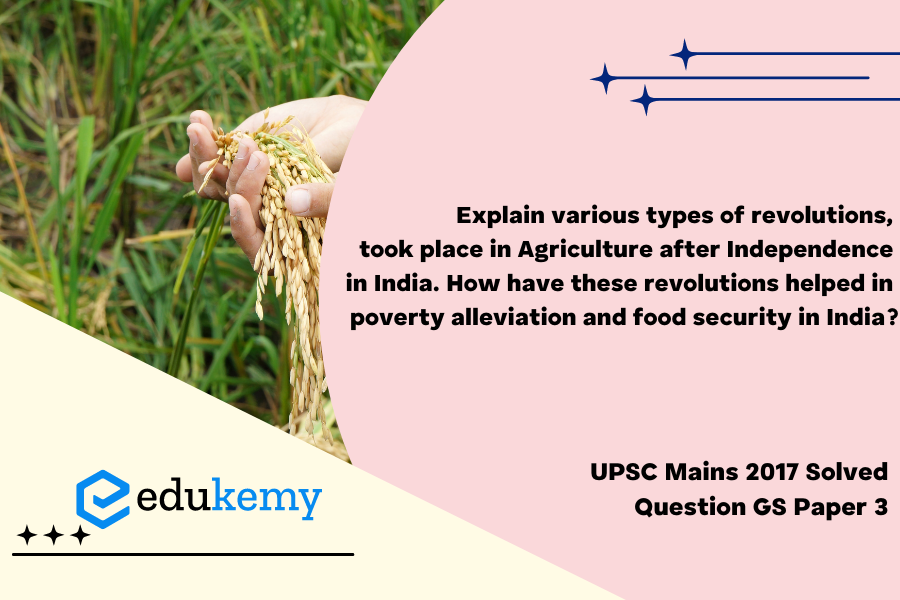Since gaining independence in 1947, India has witnessed transformative revolutions in its agricultural sector, each contributing significantly to the nation’s progress. The Green Revolution, initiated in the 1960s, marked a turning point with the introduction of high-yielding crop varieties, modern agricultural techniques, and increased irrigation. Subsequently, the White Revolution focused on dairy production, while the Blue Revolution targeted fisheries. These revolutions collectively bolstered agricultural productivity, enhancing food output and income for farmers. The technological advancements in farming practices, coupled with policy interventions, have played a crucial role in poverty alleviation by elevating the socio-economic status of rural communities. Moreover, the revolutions have contributed to food security by ensuring a consistent and diversified food supply, mitigating the risk of famine. Through these agricultural transformations, India has made commendable strides in reducing poverty and securing the nation’s food requirements.
Contents
Decoding the Question:
- In the Intro, try to write about agriculture in India.
- In Body,
- Discuss various types of agricultural revolutions in India after independence.
- Justify how these revolutions helped in poverty alleviation and food security.
- Try to conclude by relating with inclusive growth.
Answer:
India is primarily dependent on agriculture and about 60% of the population is engaged in agricultural activities. Since poverty alleviation and food security was a major target after independence the Government of India introduced various revolutions to achieve twin objectives, food security and poverty alleviation.
Major Revolutions in Agriculture in India:
- Green Revolution: This revolution led to a tremendous rise in the production of food grains, especially wheat, by the use of high-yielding varieties of seeds, fertilizers, and pesticides. In the agriculture sector in the decade of 1960, India started the green revolution, and high-yielding variety seeds were used in wheat, rice, and maize. This experiment was successful and extended to most parts of the country.
- White Revolution: Operation Flood (1970), an initiative of the National Dairy Development Board has led to a revolution in milk production in India. The world’s largest dairy development program transformed India from a milk-deficient nation to the world’s largest milk producer. This has introduced new breeding technologies, high-quality fodder, vaccination, and improved veterinary facilities.
- Blue Revolution: This revolution focussed on the management of the fisheries sector and has led to a phenomenal increase in both fish production and productivity from aquaculture and fisheries resources of the inland and marine fisheries.
- Other revolutions: Other revolutions are also significant including the yellow revolution (oil seed production), the Golden Fiber Revolution (jute), the golden revolution (horticulture), the Silver Fiber Revolution (Cotton), and the Red Revolution (meat production).

Role of Revolutions in Poverty Alleviation and Food Security:
- Innovation: These newer innovations lifted millions of people out of poverty by generating income and providing additional income sources for farming communities. Farm laborers, and reduced costs for consumers which helped people to start saving money.
- Self-sufficient: India became self-sufficient in food grain production after the Green Revolution. This has made India’s food surplus and India started to export food grain. This led to poverty alleviation.
- Dairy sector: White revolution is most significant as India has one of the largest Bovine, Cattles populations made farmers and people to engage in the dairy sector.
- Promotion of Cooperative Farming: Especially, in animal rearing cooperative dairies coming up villages and permanent and another source of income created for farmers.
- Tapping Untapped Potential: For example, developing inland and sea fisheries sectors. Traditionally farmers used to practice fisheries but the scale was small. This revolution led to increased fish production, and food security and reduced poverty.
To further carry on the momentum of these programs and assure food security in the long run in the face of an ever-increasing population, there is an urgent need for an ‘evergreen revolution’ that should focus on the all-round development of the agriculture sector. Recently the government started a green revolution that focuses on all aspects of agriculture about various products, it is also called the rainbow revolution. It also extends the results of the green revolution in the eastern part of the country, it is a technology-driven scheme.
In case you still have your doubts, contact us on 9811333901.
For UPSC Prelims Resources, Click here
For Daily Updates and Study Material:
Join our Telegram Channel – Edukemy for IAS
- 1. Learn through Videos – here
- 2. Be Exam Ready by Practicing Daily MCQs – here
- 3. Daily Newsletter – Get all your Current Affairs Covered – here
- 4. Mains Answer Writing Practice – here


